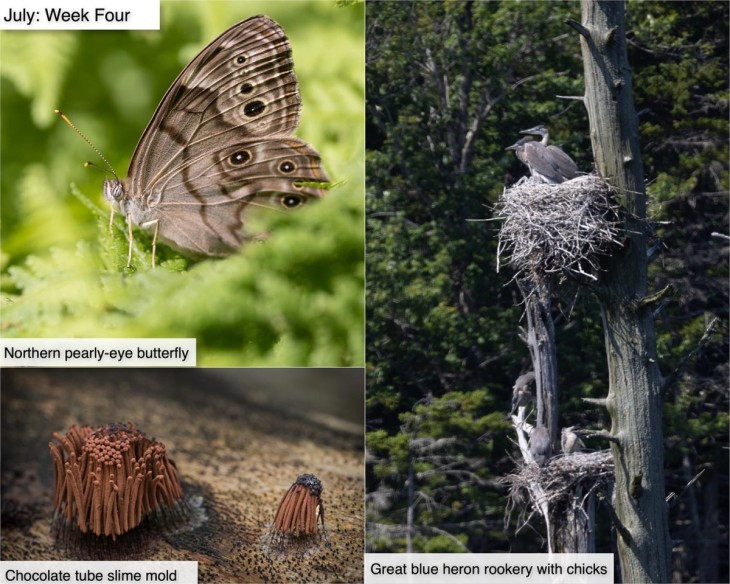This week in the woods, we’ve been seeing northern pearly-eyes fluttering up from the ferns along long woods trails. These forest butterflies – beautifully marked with black spots and rippling lines – mostly appear in shady hardwood forests, often in the vicinity of water. Their caterpillars feed on understory grasses. Like many other forest-dwelling butterflies, northern pearlies aren’t dependent on flower nectar. Instead, you’re more likely to see these butterflies feeding on animal scat, rotting fruit, or sap (for example, a wound on a sugar maple). They have one brood a year, with adults flying from June into August.
Great blue heron chicks are still in the nest, but they’re getting big, and must be feeling eager to fledge from such hot, crowded conditions. As noted by Susan Shea in this 2018 Outside Story essay, herons take a long time to grow up: about 28 days incubating in the egg, and up to another 81 as chicks in the nest. When they finally fledge, it’s a gradual and often awkward process. Check out this “web extra” to the Winter 2020 issue of Northern Woodlands magazine, documenting young herons’ early attempts at landing back in their rookery trees. As noted by writer Ron Logan,
Here you can see on bird coming in for a landing and heading for the softest spot. You can see from the pictures that the air traffic controller is visibly upset that his guidance is being ignored. For that matter, “the softest spot” isn’t too pleased either.
Another fun discovery this week – easy to overlook, but super cool under magnification – was this cluster of chocolate tube slime mold sporangia, each supported by a hair-like stalk. Despite their mushroomy looks, these bizarre organisms aren’t fungi; they’re amoeba-like organisms that clump together to form superorganisms (one giant cell with multiple nuclei) and rove around the forest floor, engulfing bacteria and other food. At some point, something triggers the slime mold to form fruiting bodies, which then produce new single cell organisms. Slime molds typically appear in damp forests. Now is a good time to look for their fruiting forms, but they’re often only centimeters high, so you’ll need a high magnification lens to fully appreciate them.
What have you noticed in the woods this week? Submit a recent photo for possible inclusion in our monthly online Reader Photo Gallery.


